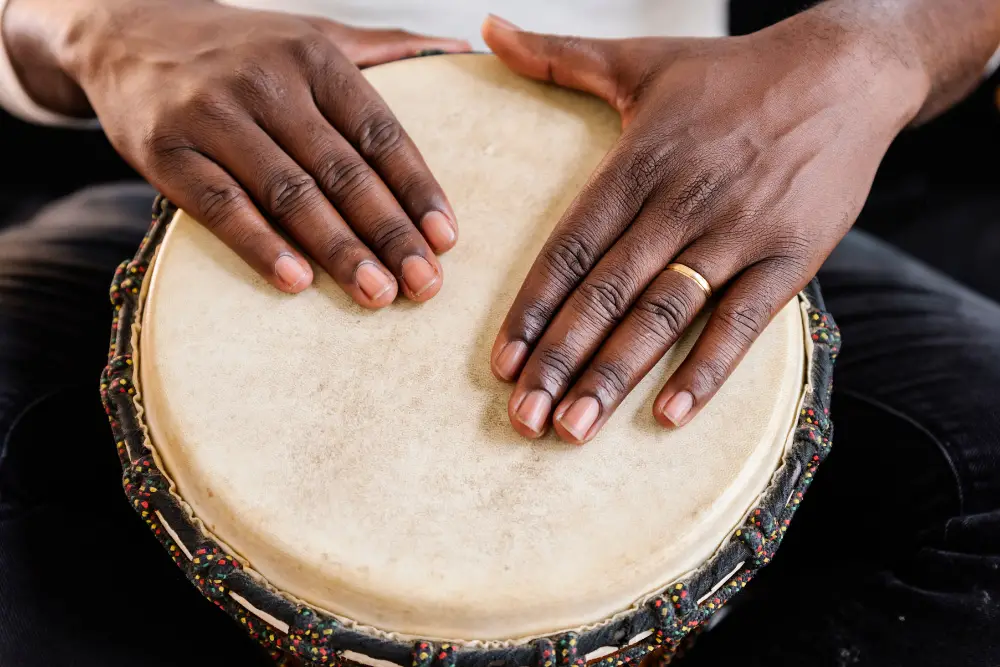Do you want you or your students to develop fluency in rhythm?
Are you looking for ways to build a sound foundation for musical understanding?
One of the most critical elements of music is rhythm, and there are few better ways to get more comfortable with it than practicing 4 beat rhythm patterns.
4 beat rhythm patterns are short enough; they don’t require too much time to practice. But they’re also long enough to practice rhythm values in their intended context.
Check out the rest of the post for 4 beat rhythm patterns, how to read, practice, and teach them.

Save time with these 60 FREE Music Resources to use in your room right away!
Stop searching the whole internet to find good activities. I’ll help you cut to the chase with my favorite 60 FREE resources.
Table of Contents
What Is A Four Beat Rhythm Or Four Beat Pattern?
Music is largely split into two main categories: time and pitch.
Beat is the implied pulse of music throughout time.
Rhythm is the length of sounds and how they occur with time and the beat.
Musicians group rhythms into blocks called measures determined by the meter.
Learn about folk songs in 6/8 meter.
A measure is counted by the number of beats it contains.
A measure in 4/4 time or meter contains 4 beats in each measure.
Therefore, a four-beat rhythm would be one measure in 4/4 time.
This is the most common and basic block of rhythm.
Inside this rhythm, musicians can put almost any rhythm they want to.
While 4/4 isn’t the only meter we can use to find 4 beat rhythm patterns, it’s the most common.
Note: For this post, we’ll look at rhythm patterns in 4/4.
4 Beat Rhythm Patterns You Need To Know
The possibilities of rhythm patterns that are 4 beats long are practically endless.
To help you, I’ve divided the rhythm patterns into different levels.
Rhythm patterns in each level will contain rhythm values in an increasingly hard way.
Use the later section for ideas on ways to practice these rhythms.
Note: I didn’t include whole notes or whole rest in these patterns since they would take up the entire measure anyway.
Level 1 – Quarter Note, Quarter Rest
It makes sense to start with these rhythms.
Quarter notes and quarter rests in 4/4 meter align with the beat, so it’s just like the beat!
At this level (which I’m sure most people will find relatively easy), all you’re practicing is sound vs. no sound.
Yes, this level is simple, but I’m a firm believer in making sure you have everything down precisely right before moving on.
Spend some time reading these with a metronome to make sure you don’t speed up or slow down the beat.
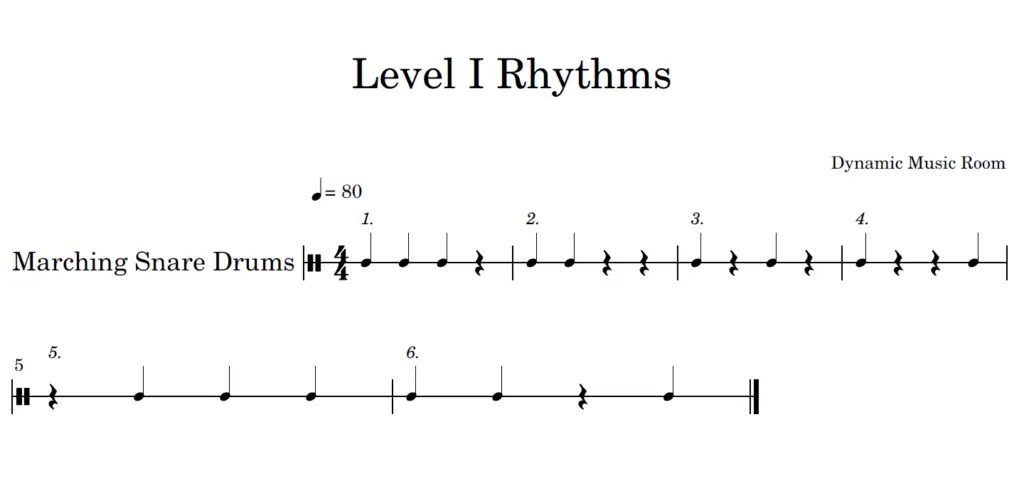
Level 2 – Adding Eighth Notes
The next logical step is the division of the beat.
In this case, we’re looking at 2 eighth notes.
Used in combination with quarter rest and quarter notes, now we’re starting to make interesting rhythms.
While there are many combinations of these rhythms alone, it’s best to use rhythms pulled from actual songs.
Lucky for you, I chose these rhythms for this exact reason.
I’ve seen all of them in various folk songs.
Check out these 17 folk songs every kid should know.
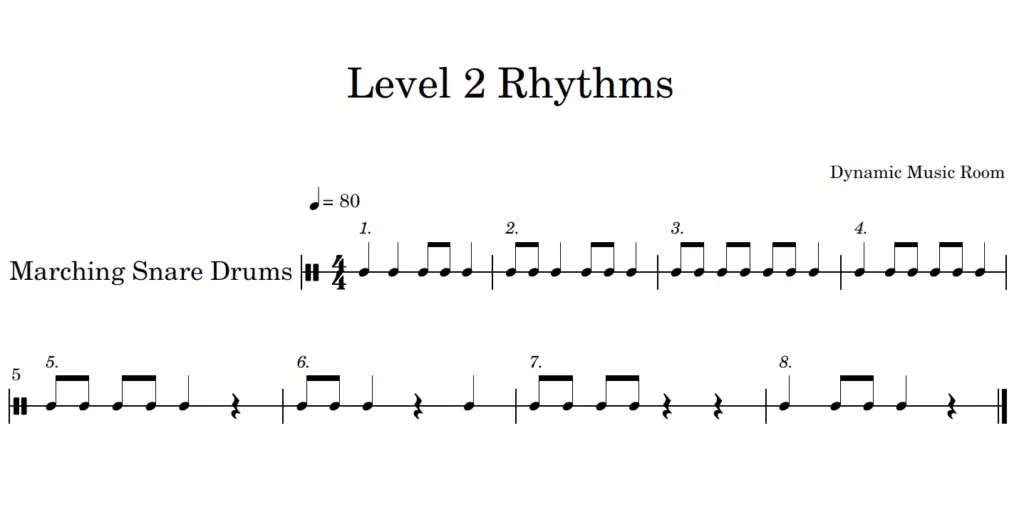
Level 3 – Half Note, Half Rest
Next, we’re adding half notes and half rest.
The trick with this rhythm is feeling the pulse of the beat while holding the note (or lack thereof) over.
We hold half notes for two beats or twice as long as quarter notes.
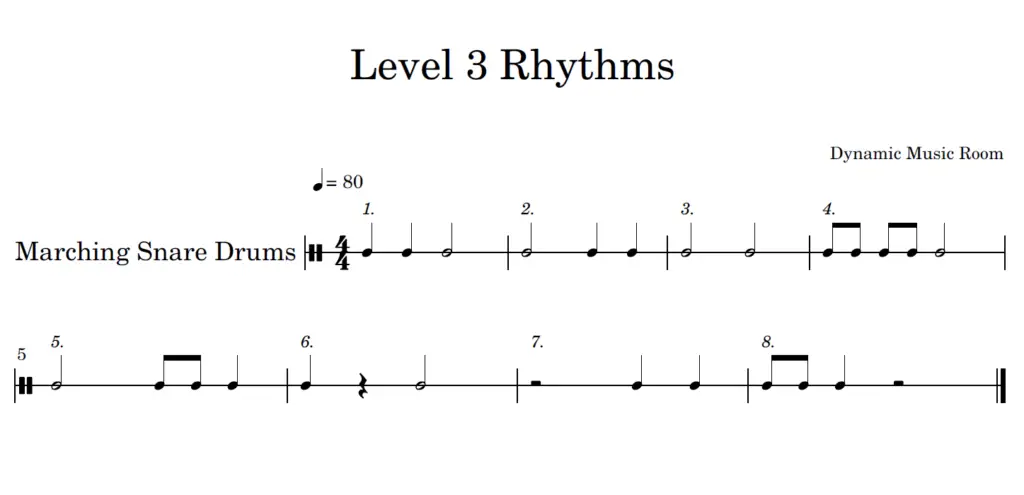
Level 4 – 4 Sixteenth Notes
Sixteenth notes are divisions of the division.
In music, we call this subdivision.
There are 4 sixteenth notes in one quarter note beat and two sixteenth notes in a single eighth note.
For this level, we’re focusing on adding groups of four sixteenth notes.
The next level includes sixteenth notes in combination with eighth notes.
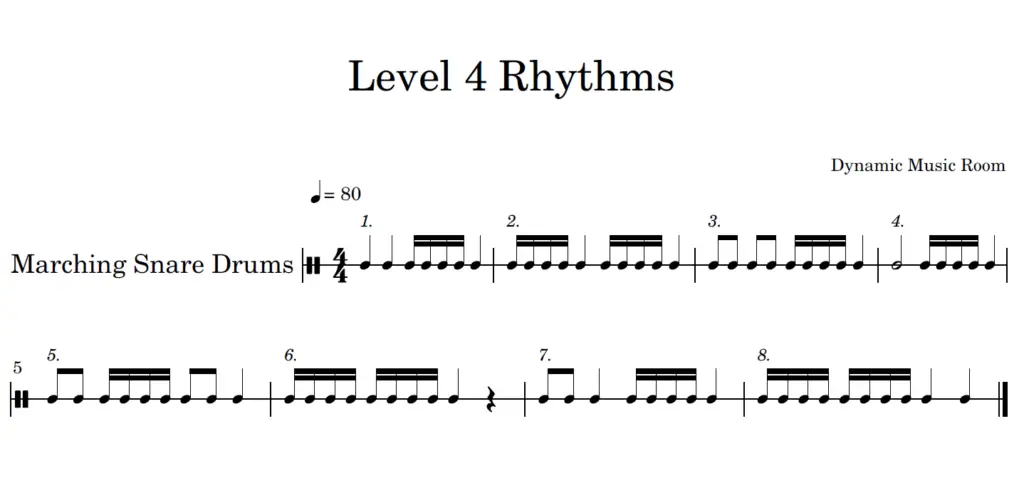
Level 5 – Eighth and Sixteenth Pairing
Level 5 includes the pairing of sixteenth notes and eighth notes.
Usually, this is in the form of either single eighth-two sixteenth or two sixteenth-eighth notes.
Both appear in these patterns.
Of the two, neither is much more common than the other.
Pro-tip: Start the rhythms slowly to make sure you have the time to perform each one.
After you do it well 5 times, speed it up bit by bit until you read a lightning speed.
Just make sure you read it correctly.
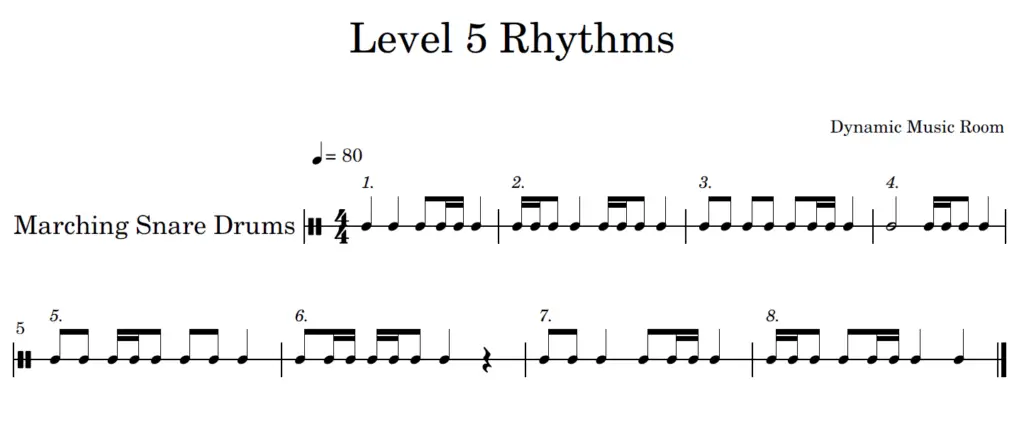
Level 6 – Dotted Quarter – Eighth
Dotted quarter-eighth is an interesting rhythm because it stretches out over the beat (like half notes), but it also contains a division of the beat.
For this one, you’ll see mostly dotted quarter THEN eighth as this is more common in music.
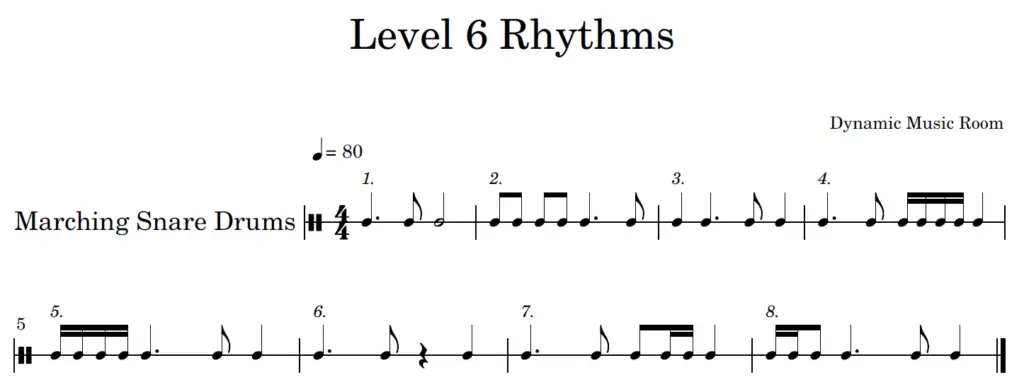
Level 7 – Beyond
Naturally, there are many more combinations of rhythms out there to fit into 4-beat patterns, but these should serve to get you started.
We haven’t even started on triplets at all.
There are also combinations of dotted eighth-sixteenth to explore and beyond.
Rhythm has no limits.
For the sake of briefness, we’ll stop there with this article, but I encourage you to go beyond if you feel ready.
For more ideas and ways to practice even more advanced rhythms, check out the next section to practice more rhythm patterns.
4 Ways To Practice 4 Beat Rhythm Patterns
There are many ways to practice rhythms and get better.
A huge part of the rhythm is a skill called fluency.
Think about learning to read and write.
After learning what each letter does and the sound it makes, the next step is to practice sight words until you recognize them without much thought.
This is where these patterns fit into place.
Over time, you master the sight words and pick up more and more.
Then, something interesting happens:
It becomes easier to sound out new words.
Why? The sight word fluency and practice give you intuitive knowledge of how letters and sounds work together.
Rhythm pattern reading is the same way.
This being said, here are 4 ways I like to practice rhythms.
These are also key for when my students practice rhythm too.
Flashcards
There’s a reason flashcards have been used to study for centuries:
They just work!
Make your own on Quizlet.
Alternately, use Google Slides and take the rhythms I use with the different levels on each slide.
After you open your Slides, click on the insert image and choose to select from the internet.
Then, search the value and insert the rhythm.
Otherwise, I recommend checking out this Note Perfect Rhythm Card Maker on Amazon.
They let you piece together rhythms in combination to make up your own.
Then, you take a picture or copy the combo you made.
Rhythm Randomizer
Rhythm randomizer is super cool.
I know that’s not a fancy or professional way of saying it, but it is!
It’s not fancy, and it doesn’t need to be.
Basically, the Rhythm Randomize gives you random rhythms to read and practice.
To make 4-beat rhythms, follow these steps:
- Go to Rhythm Randomizer.
- Click the gear icon in the upper left.
- Select “Measure Count Selection” and pick “1 measure.”
- Go to “Time Signature Selection” and make sure it says “4/4.”
- Click on “Note Selection” and choose the values you want to practice.
- Click the rhythm or ‘New Rhythm” button for auto-generated random rhythms.
Rhythm Cat
Rhythm Cat is a fun training app.
It’s interactive and pairs well with classical music.
I don’t personally agree exactly with the order they show the rhythms in, but this doesn’t mean it’s bad.
However, if you want to focus on ONLY 4-beat patterns, this isn’t for you.
All in all, it’s a great combination with the patterns from above.
Rhythm Trainer
Rhythm Trainer works for young students too, but it’s geared more for older learners.
This trainer does an excellent job of going beyond the levels I shared.
It works as an app and as a program on laptops and Chromebooks and such.
Which Rhythm Syllables Should I Use?
When reading rhythms, there are many options to use.
Older students (middle school on up) may want to consider the traditional counting system.
Adults should use this as well or check out Takadimi.
Elementary students may use anything they want, though Kodaly, Gordon/Froseth, and Takadimi are among the most common.
Check out our massive guide on rhythm syllables for all rhythm syllable systems with helpful graphics and directions.
You may also want to see a recent YouTube video I made on explaining the basics of the Kodaly rhythm syllables.
(Yeah, I make YouTube videos too. If you like it, don’t forget to subscribe!).
Final Thoughts
Now you have some 4 beat rhythm patterns to practice and improve fluency for yourself or your students.
These rhythms form the building blocks for higher musical performance later and are just a taste of the rhythm combinations.
Rhythms don’t have to be scary; they take practice.
Spend time working on it, and you’ll be impressed with how quickly you improve.
Struggling with beat vs. rhythm? Check out our worksheet and helpful ideas at the link.

